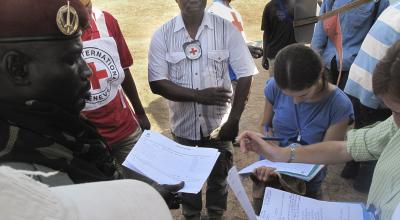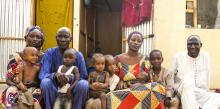Case prepared by Laura Di Gianfrancesco, Reine Pfister and Thilo Tesing, LL.M. students at Roma Tre University under the supervision of Giulio Bartolini (Professor) and Tommaso Natoli (Research assistant), Roma Tre University IHL Legal Clinic; with the contribution of Jemma Arman and Isabelle Gallino, LL.M. students at the Geneva Academy.
A. RELEASE OF 18 PEOPLE BY THE POPULAR FRONT FOR RECONSTRUCTION
“Bangui/Geneva (ICRC) – In an operation that took place yesterday, the International Committee of the Red Cross (ICRC) facilitated the transfer and release of 18 people held by the Popular Front for Reconstruction.
All were members of the Popular Army for the Restoration of the Republic and Democracy who had been detained after recent clashes in the Kaga-Bandoro area, in the north-central part of the Central African Republic. They were released in the presence of the authorities from Nana Gribizi prefecture and the Popular Army.
"The success of the operation demonstrates the trust that the groups present in the Central African Republic and the national authorities place in the ICRC and in its role as a neutral intermediary," said Katharina Ritz, the head of the ICRC delegation in the country.
The ICRC organized the transfer and release at the request of the parties. It did not take part in the negotiations that led to the detainees being released.
B. CAR AS A MEDIATOR FOR DISARMAMENT AND REPATRIATION
Report of the Secretary-General on the situation in the Central African Republic and on the activities of the United National Integrated Peacebuilding Office in that country
[…] In May, we witnessed positive developments on the implementation of the peace agreements with armed movements and rebel groups. The Government announced its intention to disarm, demobilize and reintegrate all combatants by the end of the year. Concrete steps have been taken in this regard. On 12 June, in another positive step, the Convention des patriotes pour la justice et la paix (CPJP) joined the Libreville peace process and signed a ceasefire agreement with the Government. On 13 June, Baba Laddé, the Chadian rebel leader of the Front populaire pour le redressement (FPR), signed a communiqué with the Chadian Government to start negotiations with a view to signing a peace agreement within a month to lay down its arms and for the safe passage of his group back to Chad.
The implementation of such an agreement, if followed through, could lead to the repatriation to Chad of about 400-500 elements of the FPR, which is one of the issues raised by the Armée populaire pour la restauration de la démocratie (APRD) as a precondition to disarm. We have to remember that the FPR is really a Chadian group operating in the Central African Republic; it is not a national rebel group of that country. This agreement was facilitated by the National Mediator of the Central African Republic. Here, we see the Central African Republic playing a positive role in trying to get some of these rebel groups back to their countries. […]
C. AGREEMENT BETWEEN CAR AND ARMED GROUPS ON DISARMAMENT, DEMOBILISATION, REINTEGRATION AND REPATRIATION
Preamble
[…] Bearing in mind the commitment of all political and civil society actors in the Central African Republic to achieve peace;
Bearing in mind the commitment of the international community and the global support for the Bangui Forum agreements;
In the light of the recommendations made under the “peace and security” thematic cluster of the Bangui National Forum;
Firmly resolved to strengthen the rule of law and build a national army inclusive of all segments of Central African society;
The Transitional Government of the Central African Republic and the aforementioned armed groups, in the presence of the political establishment, civil society and the international community, agree as follows: […]
Article 2
The present Agreement provides for the disarmament, demobilization, reintegration and repatriation of combatants affiliated with all the armed groups operating in the territory of the Central African Republic.
Article 3
The eligibility criteria for participation in the disarmament, demobilization, reintegration and repatriation programme are as follows:
- Combatants must be members of the armed groups signatories to the present Agreement.
- Combatants must surrender all working or non-working military weapons, explosives, mines and other military items in their possession.
- Children associated with armed forces and groups are eligible for the disarmament, demobilization, reintegration and repatriation programme, whether or not they have weapons. […]
Article 5
Bearing in mind the Commitment Agreement between the Government and the politico-military groups, the disarmament, demobilization, reintegration and repatriation programme shall comprise the following tasks, to be conducted at the sites to which candidates for the process will report:
- First, children associated with the politico-military groups will be identified, irrespective of whether or not they have a functioning weapon in their possession, with a view to redirecting them immediately to specific government programmes, with the support of partners;
- The second task will be to verify whether each candidate meets the eligibility criteria;
- Eligible combatants will then be identified and registered in a database. They will receive a demobilization card. At this stage, women will be separated from men. Women shall have the same opportunities;
- Eligible combatants will be made aware of and informed about the content of the national disarmament, demobilization, reintegration and repatriation plan. They may choose to be reintegrated into the community or to volunteer to become provisional members of the uniformed State forces under the conditions set out in article 4 of the present Agreement;
- Combatants who choose to be reintegrated into the community will be transferred to their host communities with a basic support package, and will participate with other community members in community development programmes that generate training and employment opportunities, as part of the community reintegration programme. […]
D. NATIONAL RECOVERY AND PEACEBUILDING PLAN
Overview of the needs and priorities
[…] The immediate priority will be the adoption of the national DDRR [Disarmament, Demobilisation, Reinsertion, Repatriation] strategy, which will build on the framework agreement signed in May 2015. It will enable the disarmament, demobilization, and reintegration of former combatants who meet the agreed-upon criteria, including respect of human rights, reduction of community violence, repatriation of an estimated 500 foreign combatants, and neutralization and/or destruction of weapons and ammunitions collected from the 14 armed groups targeted by the DDRR. In the short to medium term, community-based reintegration of 7,000 male and female former combatants will be undertaken. Children and women associated with armed groups, as well as vulnerable groups (handicapped or traumatized former combatants), will also be targeted by reinsertion and reintegration measures. Lastly, a Community Violence Reduction (CVR) Program will be implemented for the ex-combatants who are not eligible for participation in the national DDRR program
Discussion
I. Classification of the Situation and Applicable Law
1. How would you classify the situation in CAR? What additional information would you require in order to make such a determination? Under which conditions would Additional Protocol II be applicable? (
GC I-IV, Art. 3;
P II, Art. 1)
II. Release of Detainees and Fighters
2. (Document A) How would you classify the status of the 18 detainees of the Popular Front for Reconstruction? Is the traditional distinction between combatants and civilians applicable?
3. (Document C) Do the parties to the conflict have special obligations towards children? What does IHL say about “children associated with armed forces”? Does IHL provide any guidance on the reintegration of children that previously participated in hostilities? (
P II, Art. 4(3) and
6(4);
CIHL, Rules 135-
137)
4. Looking at Document C, and in particular Art. 5 of that document, it seems that demobilised combatants are reintegrated into the community but do not incur penalties or criminal action for their past acts. Would you say that this goes in the direction of Art. 6(5) P II? Does this provision also include war crimes? (
P II, Art. 6(5))
5. Is the demobilisation and repatriation of fighters, who are not detained, covered by IHL?
III. Elements Contributing to Respect for IHL
6. (Document A) In your opinion, would the release of the 18 people have been possible without the cooperation of the rebel group (Popular Army for Restauration of the Republic and Democracy) and the CAR authorities? What elements may have influenced both parties to sign such an agreement? What are the benefits of such cooperation? What is the advantage of having an organisation such as the ICRC as an intermediary?
7. In your opinion, what factors encouraged CAR or CAR armed groups to demobilise the fighters and to integrate them into the community? Do you think that demobilisation helps to create an environment conducive to peace? Can it help to increase the respect of IHL along the process? How? Why?
8. Do you think that granting amnesties to former fighters can be beneficial for the State itself? For society? Why? Why not? What could motivate a State to grant amnesties?






